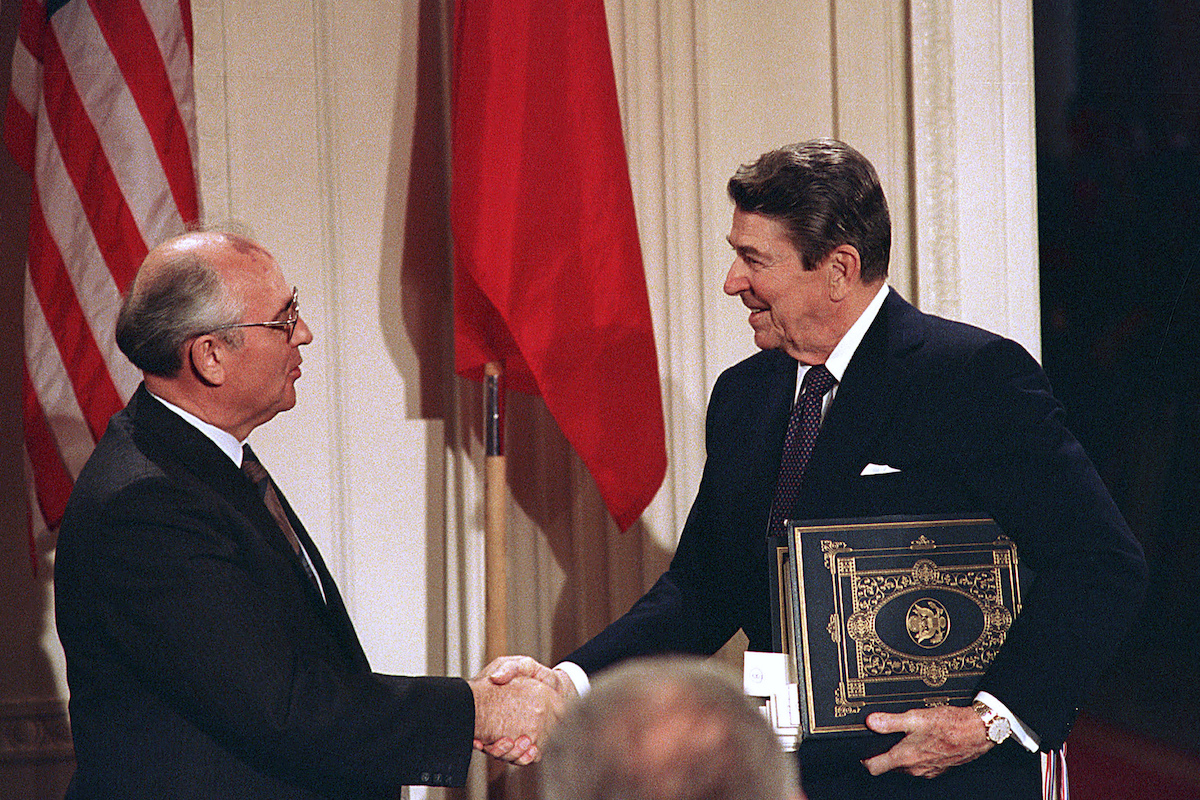Of all the writers in the limited universe of Reagan biographers (myself included), William Inboden is one I have never met. His Amazon page shows only one previous book. I was surprised by the release of his major work on Reagan, The Peacemaker: Ronald Reagan, the Cold War, and the World on the Brink, covering nearly 600 pages, augmented by many endnotes referencing numerous primary sources. The first thing that will strike anyone who grabs this thick book is the added weight of the endorsers, an impressive mix of historians, scholars, and policymakers: John Lewis Gaddis, Robert Gates, Paul Kennedy, Hal Brands, Graham Allison, among others. Several of them commend Inboden’s work as one of the very best on Ronald Reagan’s foreign policy.
As someone who has written eight books on Reagan (half of them listed in Inboden’s bibliography), I must add my name to those praising this one. It is unquestionably one of the best on Reagan’s presidency and particularly on his effort to peacefully win the Cold War.
That word peacefully says much. It is one I always try to use when writing or speaking on Reagan’s remarkable victory. Again and again, I’m careful to say not only that Reagan won the Cold War but that he peacefully won the Cold War. Typically, of course, when we hear of someone winning a war, we visualize ships and tanks and guns and grenades and exploding missiles and all the various technological innovations and initiatives. In Ronald Reagan’s case, we need to think of those as well, especially his game-changing Strategic Defense Initiative (SDI), but we need not visualize them exploding. The genius in Reagan’s strategy to win the Cold War was never to use those weapons. Unlike others who developed arsenals to win wars, Reagan’s goal was to build up in order to build down. He pursued those weapons and initiatives as defensive measures—that is, so they would never need to be used.
Reagan called this “peace through strength.” Those three words capture succinctly the strategy behind his national-security thinking.
For instance, Reagan deployed Pershing II intermediate-range nuclear forces (INFs) in Europe not to blast the USSR to smithereens, as his hysterical opponents insisted he was intending, but as bargaining chips to prompt Moscow to remove its own INFs from Eastern Europe. Eventually, under Mikhail Gorbachev, the Soviet Union did just that. Gorbachev and Reagan met at the Washington Summit in December 1987, where they signed the INF Treaty, the first-ever treaty to ban an entire class of nuclear weapons. It was extraordinary, and Reagan’s big-mouthed critics were stunned into silence.
With the INFs, Reagan had built up in order to build down.
As Inboden’s book might put it (his opening epigraph is Matt. 5:9), “Blessed are the peacemakers.” Reagan, indeed, had sought to peacefully win the Cold War. And he was driven by a religious sense to literally do God’s will on behalf of peace. To that end, what first struck me about Inboden’s book was that title, The Peacemaker, but not merely for the reasons I’ve specified thus far. The title hit me for a special reason that speaks to one of the key Reagan figures highlighted in Inboden’s book: Reagan’s closest and most important aide in the strategy and effort to peacefully take down the USSR: William P. Clark, the head of the National Security Council during the two most critical years of the Reagan effort to defeat Soviet communism, 1982 and 1983.
I was Bill Clark’s biographer and came to know him almost like a grandfather. There was a “Peacemaker” other than Reagan himself that played a special role in Clark’s life—as well as in the Reagan plan itself. And it came from Clark’s own grandfather.
Clark’s grandfather, Robert E. Clark, was a pioneer who helped settle California, which in those days was wild country. He became a U.S. forest ranger. These were Teddy Roosevelt’s guys, the men who brought law and order to the Wild West and embodied the spirit and constitution of the Rough Rider turned president they proudly served. Bob Clark was one of the first forest rangers hired for TR’s new U.S. Forest Service.
Bob met TR when the president rolled into Santa Barbara with the Great White Fleet for the Fourth of July celebration in 1908. Bob later received a commendation—a pearl-handled Colt .45 revolver called “The Peacemaker”—as a token of appreciation from the president for his service against lawlessness.
Bill Clark inherited that gun, which he brought with him as a memento to Sacramento when he became Governor Reagan’s chief of staff, and then also to Washington, when he became Reagan’s deputy secretary of state and then national security adviser. Reagan, a California transplant with a fondness for the Wild West and gunslingers, loved the Clark memento.
Fast forward several decades. In the fall of 1982, Reagan and Clark pursued the MX missile. The MX was an integral part of Reagan’s platform of peace through strength with the Soviets. Designed to carry multiple warheads, the missile would be deployed in mobile launchers. Research and development of the MX started before Reagan became president. By the time Reagan became president, however, some doubted whether the missile could be effectively deployed in a mobile manner. Many Democrats in Congress wanted to scrap the program.
Instead, Reagan talked of placing the MX in existing underground “Minuteman” missile silos. His multibillion-dollar plan began emerging in September 1982 and called for placing 100 missiles in silos, where they would be protected with thickly reinforced concrete and steel. As the Washington Post noted, the president’s decision would be “heavily influenced” by two men in particular: Secretary of Defense Cap Weinberger and Bill Clark.
The three men wished to devise a name for the MX, a name that would encapsulate the intent of the policy as well as performance. They thought of the Colt .45 owned by Clark’s grandfather, now framed and hanging on the national security adviser’s office wall in the White House basement. Reagan, however, decided to tweak it a bit, suggesting a less aggressive name—the “Peacekeeper.”
On November 22, in a speech to the nation, Reagan announced his decision to deploy 100 MX missiles. Two weeks later, on December 7, Congress voted to reject funding. The Reagan team, however, would not give up without a fight. This meant an all-out campaign on behalf of the weapon, with Clark one of the central players.
As the debate over the MX intensified, so did the opposition. A left-wing, grassroots, anti-nuclear movement rose up around the country and the world, opposing not only the MX but also such Reagan defense programs as the Pershing II missile and B-1 bomber. The so-called nuclear freeze movement turned out massive protests throughout America and Western Europe, including a crowd of nearly one million in New York City’s Central Park. The freezers included celebrities and vocal leftist groups such as Physicians for Social Responsibility. It also included the National Conference of Catholic Bishops. Clark, a devout Catholic, assumed a crucial and ultimately immeasurably valuable and successful role in dealing with the bishops.
Throughout his book, William Inboden recognizes the special role of individuals like Bill Clark in the effort to peacefully take down the USSR. The crucial chapters of the book, however, are “The Battle Is Joined” (chapter 4), “Raising the Stakes” (chapter 6), and “The Maelstrom” (chapter 7). In my own works on Reagan and the end of the Cold War, especially The Crusader: Ronald Reagan and the Fall of Communism, plus my Clark biography, The Judge: William P. Clark, Ronald Reagan’s Top Hand (co-written by Patricia Clark Doerner), I pleaded with scholars to examine the extraordinary record of NSDDs (National Security Decision Directives) produced by Clark and team in 1982 and 1983. That was where the groundwork for peaceful victory was laid. Therein were the details of the plan developed by Clark and Reagan. William Inboden gets it.
That central section of Inboden’s book is also critical because it deals (most notably in “The Maelstrom”) with the opposition and hostility of Secretary of State George Shultz and the conniving cabal of Jim Baker, Mike Deaver, Dick Darman, and even Nancy Reagan. They all turned on Clark in a nasty, devious way and sought to drive him out of office. Eventually, Clark exited in October 1983. Clark’s main lieutenants on his NSC staff, brilliant young men like Roger Robinson, John Lenczowski, Sven Kraemer, and Ken deGraffenreid, were mortified and urged him to stay. They were in agony over the recklessly stupid and arrogant White House coup being orchestrated against their humble, beloved boss. But Clark stoically, confidently encouraged them not to worry. And he was ultimately proved right. As Clark and his president realized, the foundation for victory already had been laid and the course had been set.
All along, Clark, like Reagan, was buoyed by a strong sense, literally a spiritual sense, of what he and Reagan called “the DP,” the Divine Plan. They believed that they had established a policy and plan to peacefully end the Cold War—a plan that they hoped and prayed was God’s will.
It worked, and the rest is history.
Blessed are the peacemakers. Kudos to William Inboden for getting the story right.

